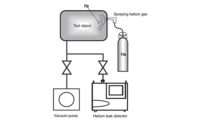Aerospace | NDT Service
Why Service Matters When Purchasing an NDT Inspection System
Selecting a service plan should go hand in hand with the system purchase.

Nondestructive testing of tire integrated into production line. Source: YXLON
When it comes to selecting an industrial nondestructive test (NDT) inspection system, quality managers invest considerable time researching systems and considering the impact of every available feature on their business. Taking into account the role of service in their equipment selection should include giving the NDT partner’s service capabilities more than a cursory review. In most instances, service and support should rate nearly as high in the decision to buy a system as the system itself. The right service package will help:
- Reduce costly downtime
- Improve inspection quality
- Guarantee operational safety
- Cut down on operating costs
- Prolong system life
With these advantages, service is key to getting the most out of any inspection system, and to continue to enhance the ROI of capital equipment into the next decade or longer. This article covers in detail why service matters when evaluating an NDT inspection system, and what service and support offerings should be considered for enhanced system efficiency and longevity.

Optimizing Inspection Systems with Advanced Services
Selecting a service plan for an NDT inspection system should go hand in hand with the system purchase, whether it’s a new implementation, converting from film or CR to digital, or switching from 2D or 3D digital radiography. From automotive and aerospace, to electronics and educational institutions, the needs of the application will help determine the appropriate solution. Requirements such as part size, material, and type of measurement factor into the system selection. Likewise, tolerance for downtime, employee turnover, skill levels, and the need to evolve all factor into service plan selection.
Take the automotive or aerospace industries, for example. In these types of inline applications, production is often happening 24/7. Inspection systems must be able to work around the clock to keep up with demand efficiently and effectively.
“When your NDT systems go down, it can create a hard stop in production,” said Kathy Scott, service sales director at Yxlon/Comet Technologies USA Inc. “For someone like a tire manufacturer, it could cause the loss of tens of thousands of dollars, with tires backed up all over the production floor.” Scott said that is why service plans in these production applications should include parts stocking and fast service call reaction. “The right service plan is critical to getting production up and running again,” she said.

Designed for the cabinet to open fully for ease of service in mind (Yxlon Cougar EVO nondestructive testing of electronics shown). Source: YXLON
Defining the Right Service Plan
Quality managers will want to see if a provider offers a standard biannual preventive maintenance plan or if they have established maintenance timelines. If they do not, then chances are they are likely not considering service with the priority deserved, which may lead to problems over a system’s service life.
While standard service plans are a good start, the best-case scenario is when a partner offers a customizable plan. Key options to look for include:
- Installation and maintenance assistance
- Production support
- Upgrade options
- Operator training and education
Modular, “à la carte” service plans, where customers can add or remove services as their business evolves, are essential. With the fast-paced nature of modern industry, along with the evolution of IoT (Internet of Things) and artificial intelligence (AI), custom and adaptable service plans offer enhanced support for the full life of a system.
“Some of these systems last 20 years or more,” said Scott. “Consider how much has changed over that period. System parts go obsolete, there are software and hardware upgrades, and changes need to be made in order to keep everything running properly.” Scott said service involves not only preventive maintenance and replacement components but ongoing training. This training is necessary when new employees come onboard or current employees need to be educated on the latest technologies. “That is why you want to select a service plan that supports your operations, both now and in the future.”
Quality managers should be able to consider their system manufacturer as a partner they can rely on to help them determine exactly what services they need to keep their NDT inspection systems running efficiently. These needs will likely change over time, so thinking of both what services are required now as well as what services may be needed in the future is important to the long-term success of a system. Here are some important value-added services to consider:

Installation and Setup
To ensure reliable system operation, the service team should handle the installation and setup of any NDT inspection system. Not only are these experts better equipped to handle the installation itself, but relying on them will also enable any product warranties. During installation, service engineers should help train internal operators on proper system implementation. Thorough training courses will enable rapid familiarization with the new system and ensure better inspections down the road. Basic training sessions should give workers the ability to configure and operate the imaging software with certainty, and to set up program flows per the application’s specifications.
Production Support
The service team should also be able to provide immediate support for limited production runs or other time-sensitive tasks. At a basic level, this includes the ability to easily provide help online or via phone. There will be times when in-person on-site support is necessary. The NDT partner should be able to quickly send an expert to the installed system location.
The NDT partner should offer customer relationship management software to view customer historical data and use the data to identify trends on the stability of the system. This enables the service expert to suggest needed maintenance, upgrades, and spare parts inventory. Some go an additional step and are transparent with the customer about this data.
Some NDT partners are digitalizing the service processes, which involves creating so-called digital twins, or exact digital representations, of the inspection systems. These simplify the work of the service teams by creating a basis for predictive maintenance.
Ongoing Maintenance and Repairs
Preventive maintenance is key to the longevity of any NDT inspection system. Maintenance checks are usually scheduled annually or biannually, although the partner should be able to conduct visits at whatever intervals are required. Having the service team assist with preventive maintenance at regular intervals will help to:
- Increase system lifespan
- Ensure and preserve operational reliability
- Guarantee operational safety
- Avoid costly damage and downtime
Maintenance is not just about preventing major problems, but also about dealing with normal wear and tear. Scott says “It is good to have a spare parts package worked into a service plan. Look for consignment inventory with a ‘pay as you go’ model or other custom options. ‘Pay as you go’ enables the customer to stock parts in-house that are known to have a shorter life span, to be used and invoiced individually, as needed. Also, for continuous operations like a production line, having a service team with a deep well of knowledge and ability to help remotely or to arrive in person quickly can be a critical resource.” “For 24/7 operations, part availability is the number one thing that I hear about,” said Scott. “Having service engineers who quickly respond by phone, in person or virtually is a close second. With consignment inventory and reliable service response times, customers can stay on track with their production goals.”
Another very important decision option that should be made available is whether to purchase minimal or ‘bumper-to-bumper’ warranty options. A minimal warranty may be the best choice financially, but it may need to be enhanced with additional service options as time goes by.
Upgrades and System Improvement Options
Because businesses likely will not look the same five years from now as they do today, ongoing upgrades and system improvements can help companies using non-destructive testing (NDT) stay competitive.

Finding a great product with exceptional service for the long term can happen if you know what to look for (YXLON UX20 shown). Source: YXLON
Keeping technology up to date will help quality managers to not only improve system performance and efficiency, but also help to extend the product life of their systems. Service plans should include regular hardware and software updates.
By the way, by purchasing an upgradeable system, a manufacturer can potentially save money down the road. For example, adding computed tomography (3D) capability to an existing 2D system rather than buying a new system may save hundreds of thousands of dollars.
Further/Ongoing Operator Training
NDT partners should be able to train workers on enhanced use of the NDT inspection system. This requires a close relationship with the partner, so the service team is able to recognize opportunities for improvement. The best and most relevant training happens onsite at the customer location using the customer’s own parts.
Virtual training, like basic and special opt-in webinars with experts in nondestructive testing, will help to upskill current workers and to train new employees. The more workers understand about their system, the better they will be able to improve quality and manage issues on their own. For example, workers may receive training on how to replace parts and do other basic maintenance, decreasing downtime.
Simply Put: Service Matters
With a strong service team in place, supported by the right service plan, companies will be positioned to get the most value out of their sizable investment in an industrial digital radiography or computed tomography inspection system. Here are some frequent examples of why quick and knowledgeable partner support is important:
- With a short pass/fail determination inline application, downtime in the inspection system may halt production. It can quickly create a deep and costly backup.
- Short term production runs may need immediate support from a partner application engineer to assist with temporary changes.
- Over the long term, changing inspection needs could require upgradable options, additional or replacement components, and possibly new training on software and hardware.
- Unplanned employee turnover could require that training be immediately available.
- Manufacturers who run inspections 24/7 may encounter problems in the middle of the night or on weekends, when the in-house expert is not available.
These are the some of the main reasons why, when searching for a new 2D or 3D inspection system, decision makers should consider service as an essential partnership. The potential benefits may include avoiding downtime, cutting operational costs, improving inspection quality, and prolonging system service life.
“Over the 29 years I’ve been in the industry, the one thing I hear from customers over and over again is the importance of service,” said Scott. “When customers find a good service plan from a reliable partner that actually delivers on those promises, then they know they are truly taken care of.”
All Images Source: YXLON
For more information, email yxlon@yxlon.com or visit www.yxlon.com
Looking for a reprint of this article?
From high-res PDFs to custom plaques, order your copy today!





